Circular Economy: Creating Competitive Advantage in Business
VerifiedAdded on 2020/03/16
|10
|2288
|52
Report
AI Summary
This report delves into the principles and benefits of the circular economy, emphasizing its role in creating competitive advantages for businesses. It explores how companies can reduce waste, improve resource productivity, and address resource security through recycling and reuse. The report highlights the manufacturing sector's adoption of circular economy practices, using Omni United as a case study. It also provides recommendations for successful implementation, including partnerships and sustainable practices. The report concludes by stressing the importance of the circular economy for business sustainability and environmental conservation. This report is contributed by a student and is available on Desklib, a platform offering AI-based study tools.
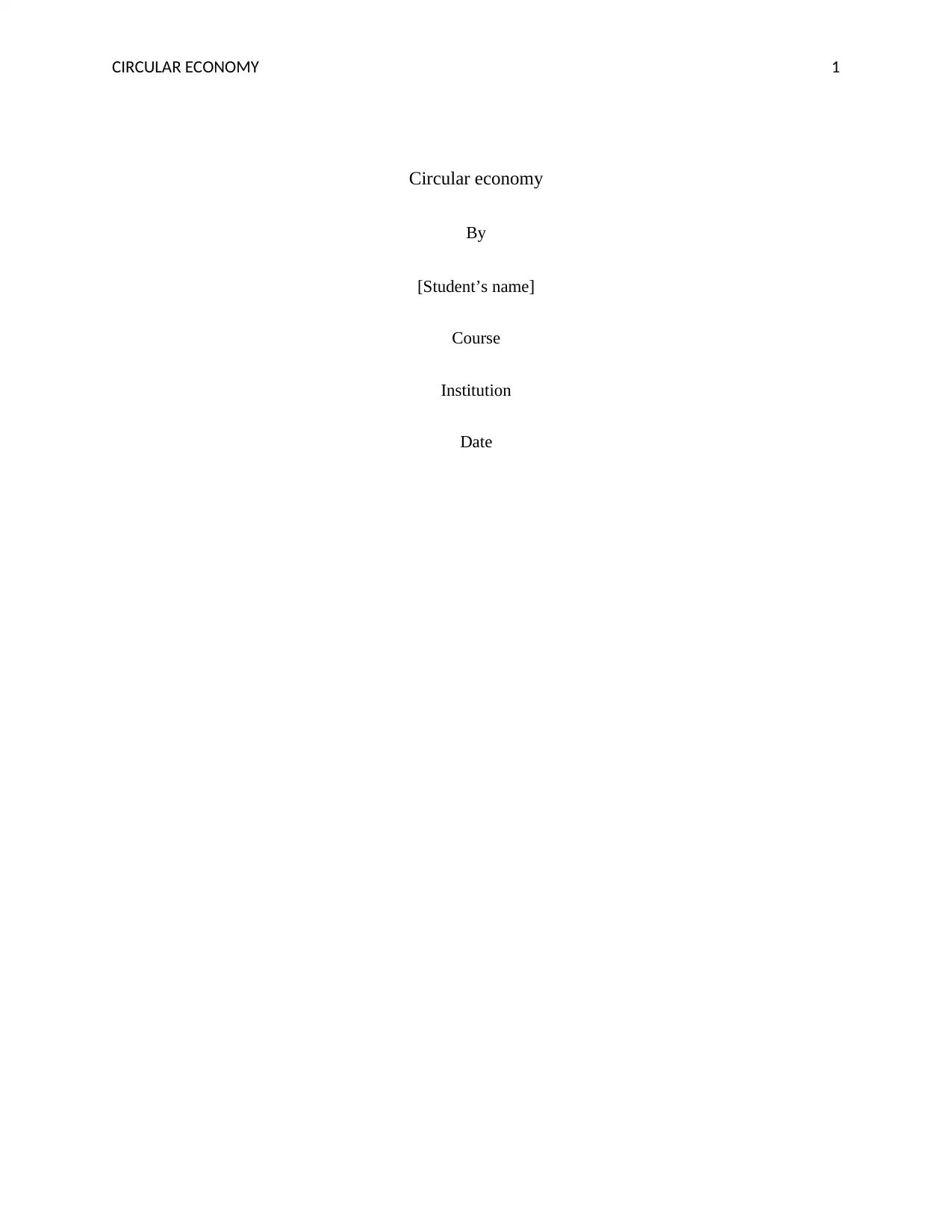
CIRCULAR ECONOMY 1
Circular economy
By
[Student’s name]
Course
Institution
Date
Circular economy
By
[Student’s name]
Course
Institution
Date
Paraphrase This Document
Need a fresh take? Get an instant paraphrase of this document with our AI Paraphraser
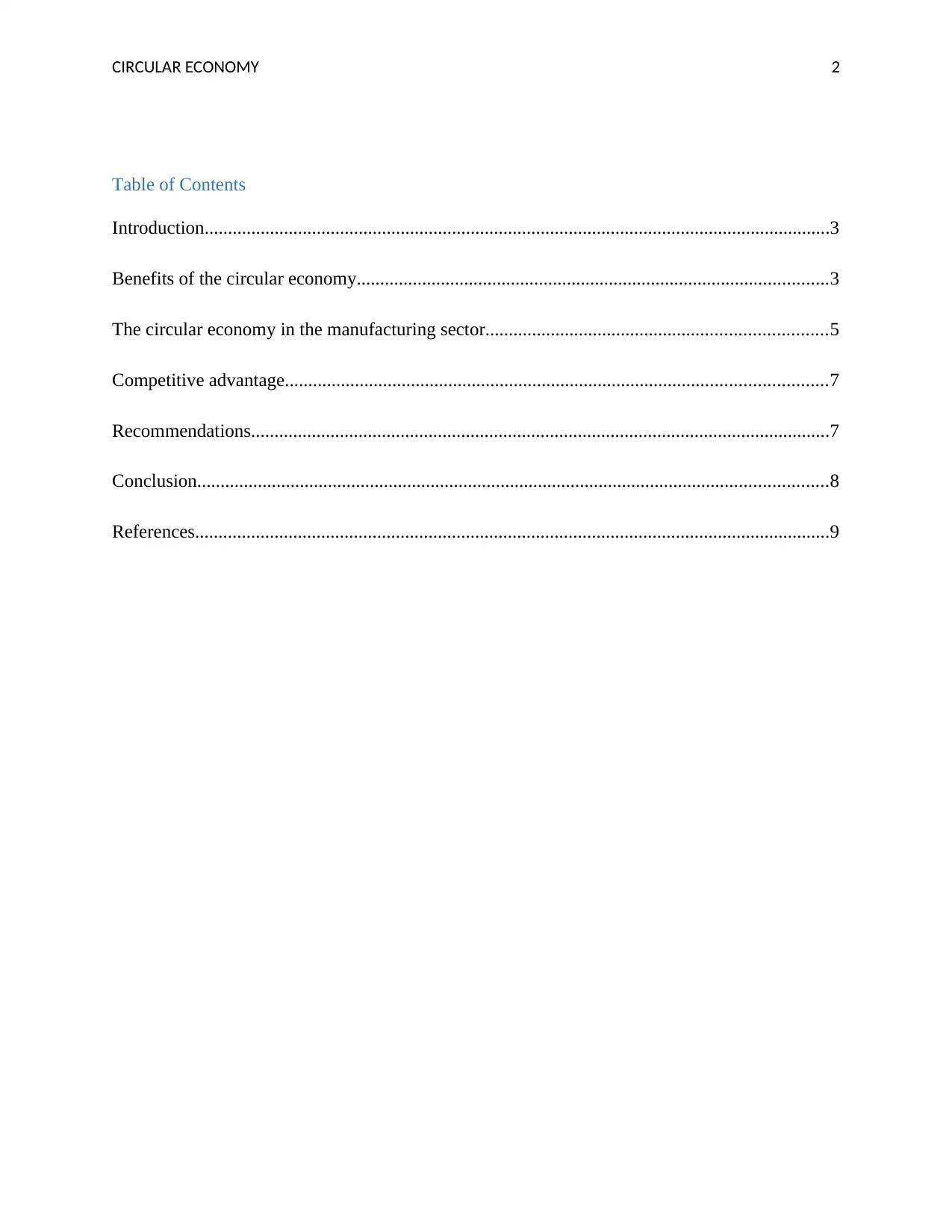
CIRCULAR ECONOMY 2
Table of Contents
Introduction......................................................................................................................................3
Benefits of the circular economy.....................................................................................................3
The circular economy in the manufacturing sector.........................................................................5
Competitive advantage....................................................................................................................7
Recommendations............................................................................................................................7
Conclusion.......................................................................................................................................8
References........................................................................................................................................9
Table of Contents
Introduction......................................................................................................................................3
Benefits of the circular economy.....................................................................................................3
The circular economy in the manufacturing sector.........................................................................5
Competitive advantage....................................................................................................................7
Recommendations............................................................................................................................7
Conclusion.......................................................................................................................................8
References........................................................................................................................................9
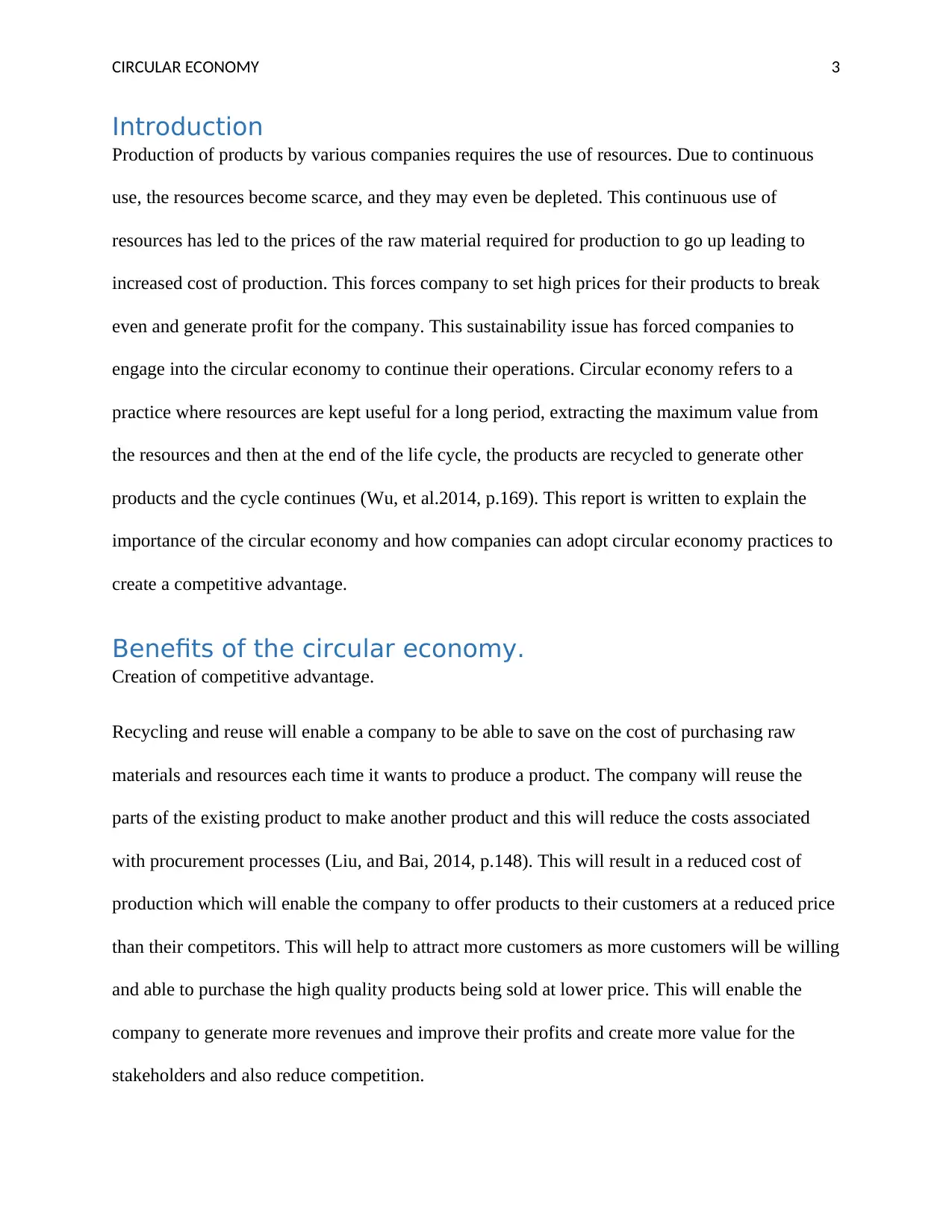
CIRCULAR ECONOMY 3
Introduction
Production of products by various companies requires the use of resources. Due to continuous
use, the resources become scarce, and they may even be depleted. This continuous use of
resources has led to the prices of the raw material required for production to go up leading to
increased cost of production. This forces company to set high prices for their products to break
even and generate profit for the company. This sustainability issue has forced companies to
engage into the circular economy to continue their operations. Circular economy refers to a
practice where resources are kept useful for a long period, extracting the maximum value from
the resources and then at the end of the life cycle, the products are recycled to generate other
products and the cycle continues (Wu, et al.2014, p.169). This report is written to explain the
importance of the circular economy and how companies can adopt circular economy practices to
create a competitive advantage.
Benefits of the circular economy.
Creation of competitive advantage.
Recycling and reuse will enable a company to be able to save on the cost of purchasing raw
materials and resources each time it wants to produce a product. The company will reuse the
parts of the existing product to make another product and this will reduce the costs associated
with procurement processes (Liu, and Bai, 2014, p.148). This will result in a reduced cost of
production which will enable the company to offer products to their customers at a reduced price
than their competitors. This will help to attract more customers as more customers will be willing
and able to purchase the high quality products being sold at lower price. This will enable the
company to generate more revenues and improve their profits and create more value for the
stakeholders and also reduce competition.
Introduction
Production of products by various companies requires the use of resources. Due to continuous
use, the resources become scarce, and they may even be depleted. This continuous use of
resources has led to the prices of the raw material required for production to go up leading to
increased cost of production. This forces company to set high prices for their products to break
even and generate profit for the company. This sustainability issue has forced companies to
engage into the circular economy to continue their operations. Circular economy refers to a
practice where resources are kept useful for a long period, extracting the maximum value from
the resources and then at the end of the life cycle, the products are recycled to generate other
products and the cycle continues (Wu, et al.2014, p.169). This report is written to explain the
importance of the circular economy and how companies can adopt circular economy practices to
create a competitive advantage.
Benefits of the circular economy.
Creation of competitive advantage.
Recycling and reuse will enable a company to be able to save on the cost of purchasing raw
materials and resources each time it wants to produce a product. The company will reuse the
parts of the existing product to make another product and this will reduce the costs associated
with procurement processes (Liu, and Bai, 2014, p.148). This will result in a reduced cost of
production which will enable the company to offer products to their customers at a reduced price
than their competitors. This will help to attract more customers as more customers will be willing
and able to purchase the high quality products being sold at lower price. This will enable the
company to generate more revenues and improve their profits and create more value for the
stakeholders and also reduce competition.
⊘ This is a preview!⊘
Do you want full access?
Subscribe today to unlock all pages.

Trusted by 1+ million students worldwide
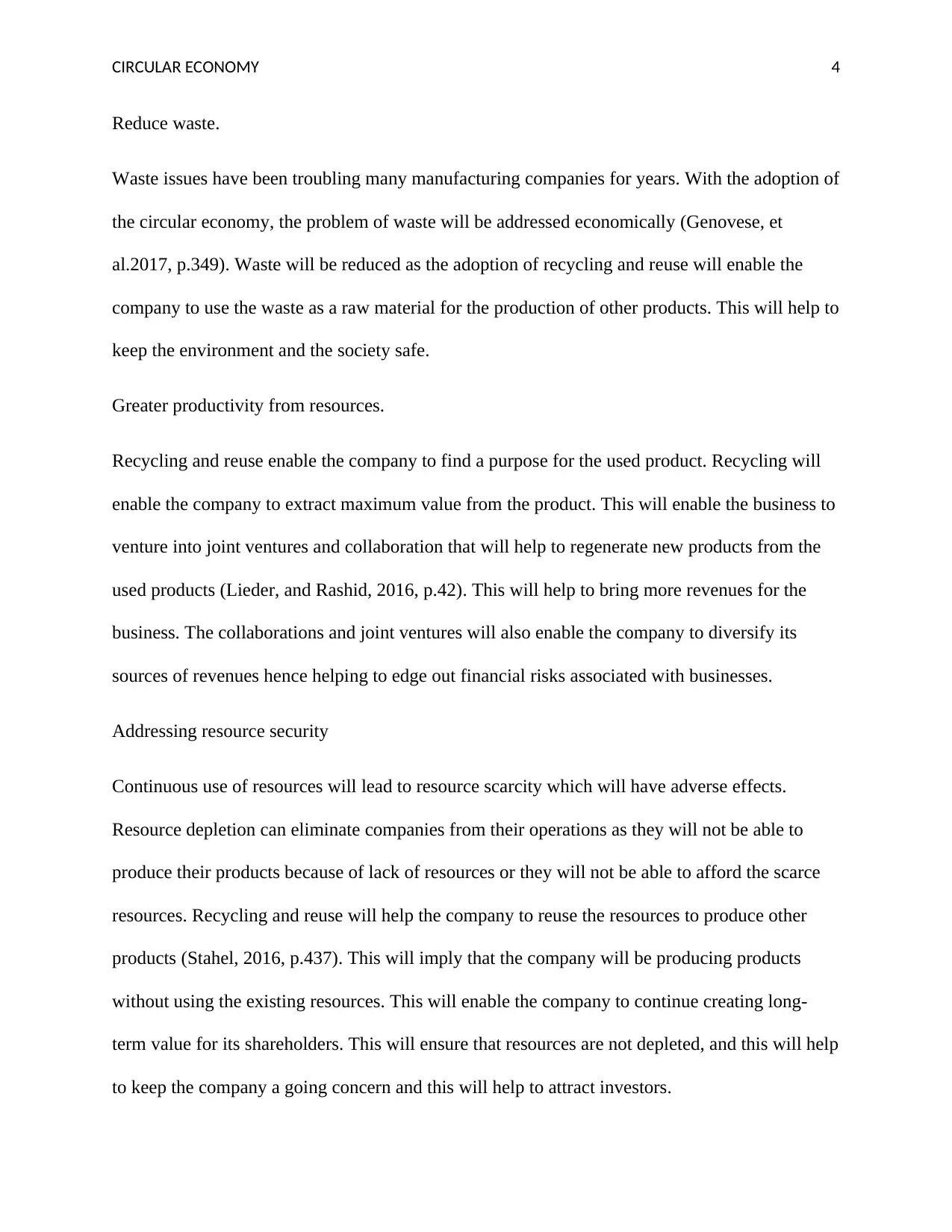
CIRCULAR ECONOMY 4
Reduce waste.
Waste issues have been troubling many manufacturing companies for years. With the adoption of
the circular economy, the problem of waste will be addressed economically (Genovese, et
al.2017, p.349). Waste will be reduced as the adoption of recycling and reuse will enable the
company to use the waste as a raw material for the production of other products. This will help to
keep the environment and the society safe.
Greater productivity from resources.
Recycling and reuse enable the company to find a purpose for the used product. Recycling will
enable the company to extract maximum value from the product. This will enable the business to
venture into joint ventures and collaboration that will help to regenerate new products from the
used products (Lieder, and Rashid, 2016, p.42). This will help to bring more revenues for the
business. The collaborations and joint ventures will also enable the company to diversify its
sources of revenues hence helping to edge out financial risks associated with businesses.
Addressing resource security
Continuous use of resources will lead to resource scarcity which will have adverse effects.
Resource depletion can eliminate companies from their operations as they will not be able to
produce their products because of lack of resources or they will not be able to afford the scarce
resources. Recycling and reuse will help the company to reuse the resources to produce other
products (Stahel, 2016, p.437). This will imply that the company will be producing products
without using the existing resources. This will enable the company to continue creating long-
term value for its shareholders. This will ensure that resources are not depleted, and this will help
to keep the company a going concern and this will help to attract investors.
Reduce waste.
Waste issues have been troubling many manufacturing companies for years. With the adoption of
the circular economy, the problem of waste will be addressed economically (Genovese, et
al.2017, p.349). Waste will be reduced as the adoption of recycling and reuse will enable the
company to use the waste as a raw material for the production of other products. This will help to
keep the environment and the society safe.
Greater productivity from resources.
Recycling and reuse enable the company to find a purpose for the used product. Recycling will
enable the company to extract maximum value from the product. This will enable the business to
venture into joint ventures and collaboration that will help to regenerate new products from the
used products (Lieder, and Rashid, 2016, p.42). This will help to bring more revenues for the
business. The collaborations and joint ventures will also enable the company to diversify its
sources of revenues hence helping to edge out financial risks associated with businesses.
Addressing resource security
Continuous use of resources will lead to resource scarcity which will have adverse effects.
Resource depletion can eliminate companies from their operations as they will not be able to
produce their products because of lack of resources or they will not be able to afford the scarce
resources. Recycling and reuse will help the company to reuse the resources to produce other
products (Stahel, 2016, p.437). This will imply that the company will be producing products
without using the existing resources. This will enable the company to continue creating long-
term value for its shareholders. This will ensure that resources are not depleted, and this will help
to keep the company a going concern and this will help to attract investors.
Paraphrase This Document
Need a fresh take? Get an instant paraphrase of this document with our AI Paraphraser
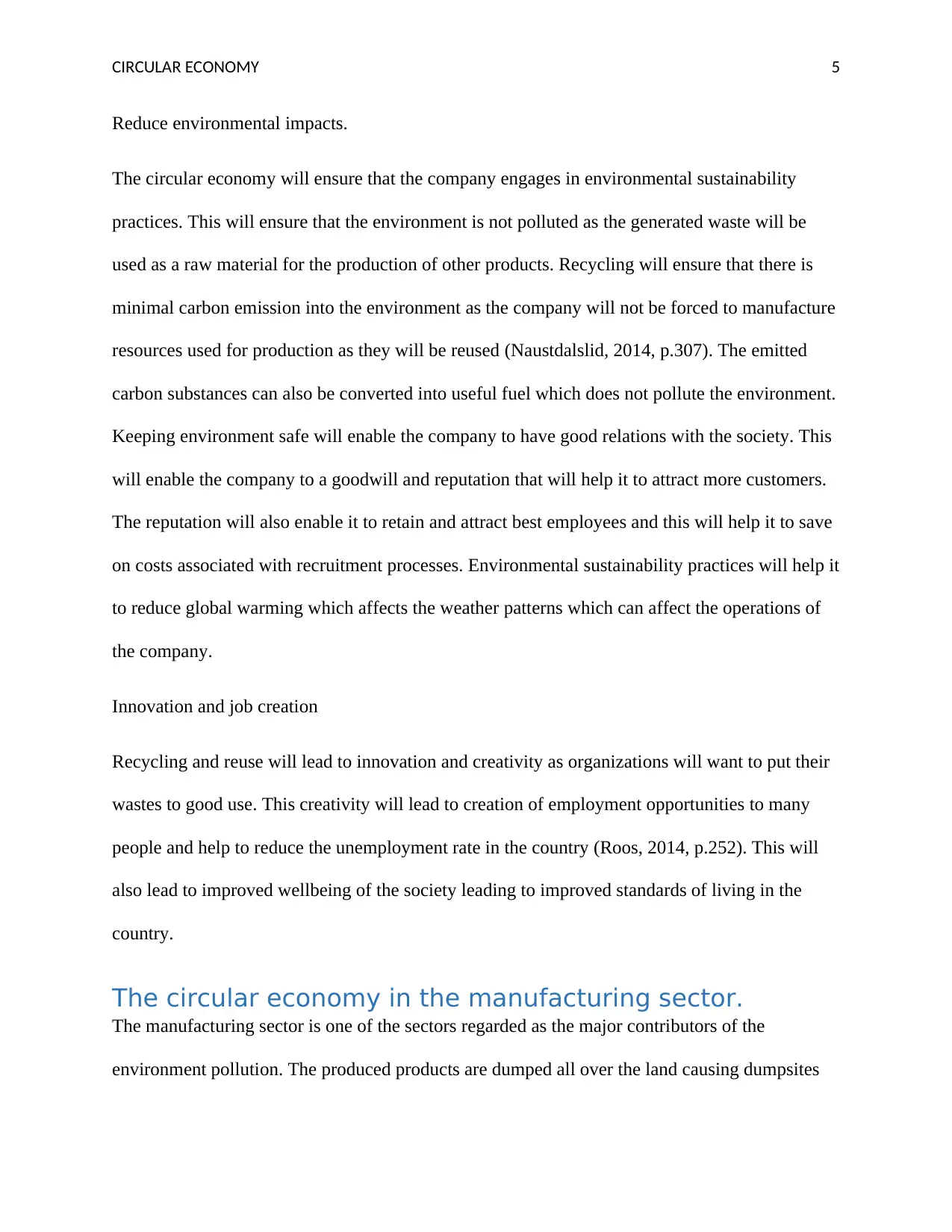
CIRCULAR ECONOMY 5
Reduce environmental impacts.
The circular economy will ensure that the company engages in environmental sustainability
practices. This will ensure that the environment is not polluted as the generated waste will be
used as a raw material for the production of other products. Recycling will ensure that there is
minimal carbon emission into the environment as the company will not be forced to manufacture
resources used for production as they will be reused (Naustdalslid, 2014, p.307). The emitted
carbon substances can also be converted into useful fuel which does not pollute the environment.
Keeping environment safe will enable the company to have good relations with the society. This
will enable the company to a goodwill and reputation that will help it to attract more customers.
The reputation will also enable it to retain and attract best employees and this will help it to save
on costs associated with recruitment processes. Environmental sustainability practices will help it
to reduce global warming which affects the weather patterns which can affect the operations of
the company.
Innovation and job creation
Recycling and reuse will lead to innovation and creativity as organizations will want to put their
wastes to good use. This creativity will lead to creation of employment opportunities to many
people and help to reduce the unemployment rate in the country (Roos, 2014, p.252). This will
also lead to improved wellbeing of the society leading to improved standards of living in the
country.
The circular economy in the manufacturing sector.
The manufacturing sector is one of the sectors regarded as the major contributors of the
environment pollution. The produced products are dumped all over the land causing dumpsites
Reduce environmental impacts.
The circular economy will ensure that the company engages in environmental sustainability
practices. This will ensure that the environment is not polluted as the generated waste will be
used as a raw material for the production of other products. Recycling will ensure that there is
minimal carbon emission into the environment as the company will not be forced to manufacture
resources used for production as they will be reused (Naustdalslid, 2014, p.307). The emitted
carbon substances can also be converted into useful fuel which does not pollute the environment.
Keeping environment safe will enable the company to have good relations with the society. This
will enable the company to a goodwill and reputation that will help it to attract more customers.
The reputation will also enable it to retain and attract best employees and this will help it to save
on costs associated with recruitment processes. Environmental sustainability practices will help it
to reduce global warming which affects the weather patterns which can affect the operations of
the company.
Innovation and job creation
Recycling and reuse will lead to innovation and creativity as organizations will want to put their
wastes to good use. This creativity will lead to creation of employment opportunities to many
people and help to reduce the unemployment rate in the country (Roos, 2014, p.252). This will
also lead to improved wellbeing of the society leading to improved standards of living in the
country.
The circular economy in the manufacturing sector.
The manufacturing sector is one of the sectors regarded as the major contributors of the
environment pollution. The produced products are dumped all over the land causing dumpsites
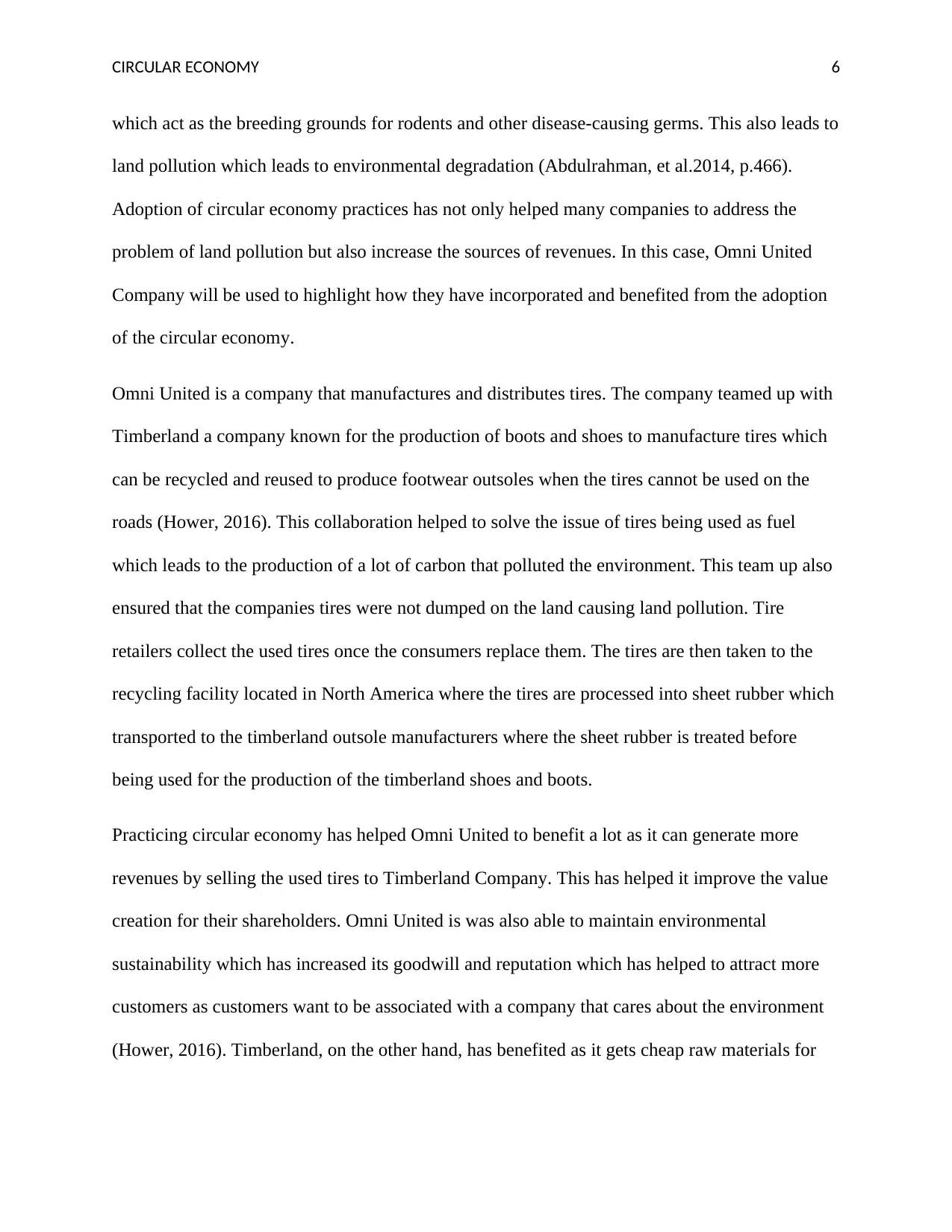
CIRCULAR ECONOMY 6
which act as the breeding grounds for rodents and other disease-causing germs. This also leads to
land pollution which leads to environmental degradation (Abdulrahman, et al.2014, p.466).
Adoption of circular economy practices has not only helped many companies to address the
problem of land pollution but also increase the sources of revenues. In this case, Omni United
Company will be used to highlight how they have incorporated and benefited from the adoption
of the circular economy.
Omni United is a company that manufactures and distributes tires. The company teamed up with
Timberland a company known for the production of boots and shoes to manufacture tires which
can be recycled and reused to produce footwear outsoles when the tires cannot be used on the
roads (Hower, 2016). This collaboration helped to solve the issue of tires being used as fuel
which leads to the production of a lot of carbon that polluted the environment. This team up also
ensured that the companies tires were not dumped on the land causing land pollution. Tire
retailers collect the used tires once the consumers replace them. The tires are then taken to the
recycling facility located in North America where the tires are processed into sheet rubber which
transported to the timberland outsole manufacturers where the sheet rubber is treated before
being used for the production of the timberland shoes and boots.
Practicing circular economy has helped Omni United to benefit a lot as it can generate more
revenues by selling the used tires to Timberland Company. This has helped it improve the value
creation for their shareholders. Omni United is was also able to maintain environmental
sustainability which has increased its goodwill and reputation which has helped to attract more
customers as customers want to be associated with a company that cares about the environment
(Hower, 2016). Timberland, on the other hand, has benefited as it gets cheap raw materials for
which act as the breeding grounds for rodents and other disease-causing germs. This also leads to
land pollution which leads to environmental degradation (Abdulrahman, et al.2014, p.466).
Adoption of circular economy practices has not only helped many companies to address the
problem of land pollution but also increase the sources of revenues. In this case, Omni United
Company will be used to highlight how they have incorporated and benefited from the adoption
of the circular economy.
Omni United is a company that manufactures and distributes tires. The company teamed up with
Timberland a company known for the production of boots and shoes to manufacture tires which
can be recycled and reused to produce footwear outsoles when the tires cannot be used on the
roads (Hower, 2016). This collaboration helped to solve the issue of tires being used as fuel
which leads to the production of a lot of carbon that polluted the environment. This team up also
ensured that the companies tires were not dumped on the land causing land pollution. Tire
retailers collect the used tires once the consumers replace them. The tires are then taken to the
recycling facility located in North America where the tires are processed into sheet rubber which
transported to the timberland outsole manufacturers where the sheet rubber is treated before
being used for the production of the timberland shoes and boots.
Practicing circular economy has helped Omni United to benefit a lot as it can generate more
revenues by selling the used tires to Timberland Company. This has helped it improve the value
creation for their shareholders. Omni United is was also able to maintain environmental
sustainability which has increased its goodwill and reputation which has helped to attract more
customers as customers want to be associated with a company that cares about the environment
(Hower, 2016). Timberland, on the other hand, has benefited as it gets cheap raw materials for
⊘ This is a preview!⊘
Do you want full access?
Subscribe today to unlock all pages.

Trusted by 1+ million students worldwide
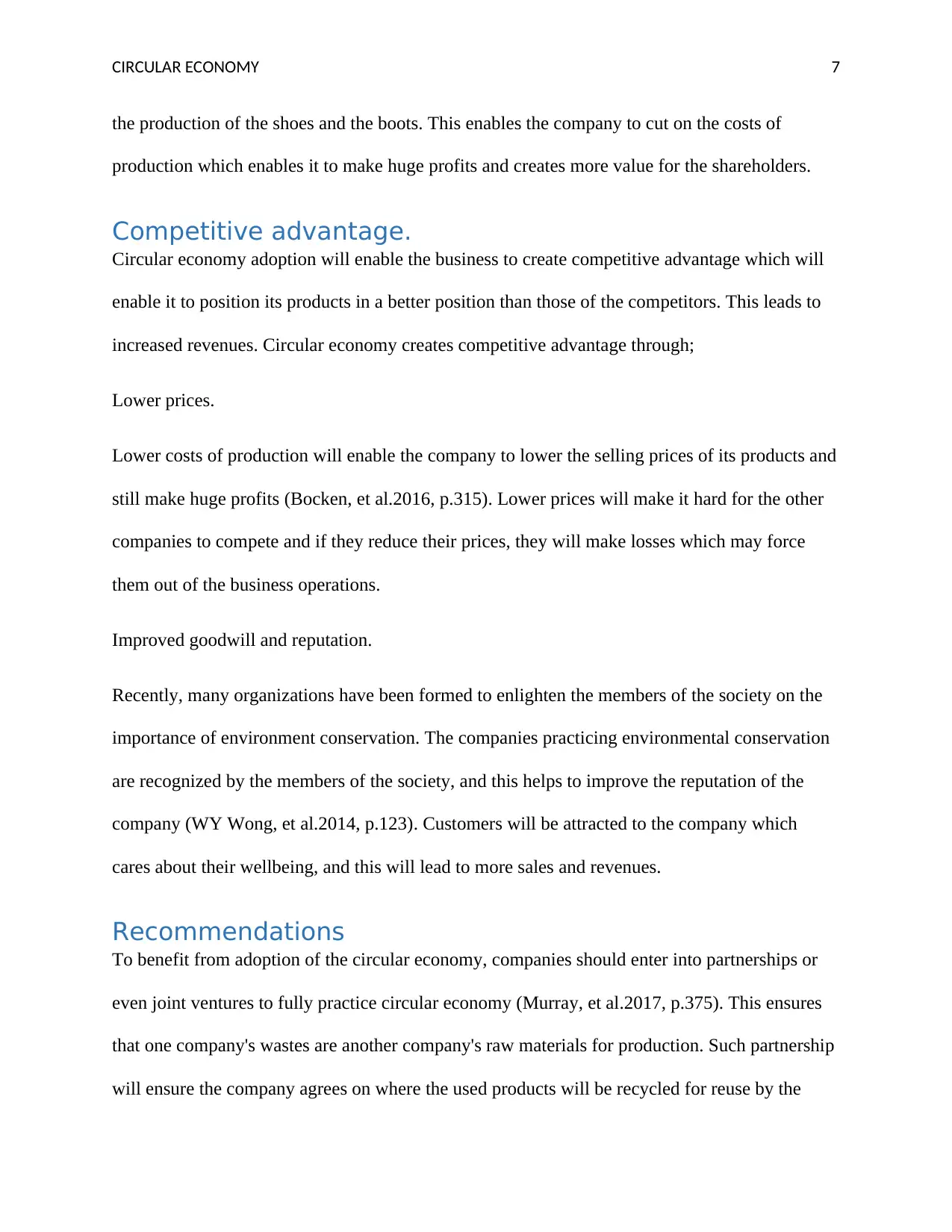
CIRCULAR ECONOMY 7
the production of the shoes and the boots. This enables the company to cut on the costs of
production which enables it to make huge profits and creates more value for the shareholders.
Competitive advantage.
Circular economy adoption will enable the business to create competitive advantage which will
enable it to position its products in a better position than those of the competitors. This leads to
increased revenues. Circular economy creates competitive advantage through;
Lower prices.
Lower costs of production will enable the company to lower the selling prices of its products and
still make huge profits (Bocken, et al.2016, p.315). Lower prices will make it hard for the other
companies to compete and if they reduce their prices, they will make losses which may force
them out of the business operations.
Improved goodwill and reputation.
Recently, many organizations have been formed to enlighten the members of the society on the
importance of environment conservation. The companies practicing environmental conservation
are recognized by the members of the society, and this helps to improve the reputation of the
company (WY Wong, et al.2014, p.123). Customers will be attracted to the company which
cares about their wellbeing, and this will lead to more sales and revenues.
Recommendations
To benefit from adoption of the circular economy, companies should enter into partnerships or
even joint ventures to fully practice circular economy (Murray, et al.2017, p.375). This ensures
that one company's wastes are another company's raw materials for production. Such partnership
will ensure the company agrees on where the used products will be recycled for reuse by the
the production of the shoes and the boots. This enables the company to cut on the costs of
production which enables it to make huge profits and creates more value for the shareholders.
Competitive advantage.
Circular economy adoption will enable the business to create competitive advantage which will
enable it to position its products in a better position than those of the competitors. This leads to
increased revenues. Circular economy creates competitive advantage through;
Lower prices.
Lower costs of production will enable the company to lower the selling prices of its products and
still make huge profits (Bocken, et al.2016, p.315). Lower prices will make it hard for the other
companies to compete and if they reduce their prices, they will make losses which may force
them out of the business operations.
Improved goodwill and reputation.
Recently, many organizations have been formed to enlighten the members of the society on the
importance of environment conservation. The companies practicing environmental conservation
are recognized by the members of the society, and this helps to improve the reputation of the
company (WY Wong, et al.2014, p.123). Customers will be attracted to the company which
cares about their wellbeing, and this will lead to more sales and revenues.
Recommendations
To benefit from adoption of the circular economy, companies should enter into partnerships or
even joint ventures to fully practice circular economy (Murray, et al.2017, p.375). This ensures
that one company's wastes are another company's raw materials for production. Such partnership
will ensure the company agrees on where the used products will be recycled for reuse by the
Paraphrase This Document
Need a fresh take? Get an instant paraphrase of this document with our AI Paraphraser
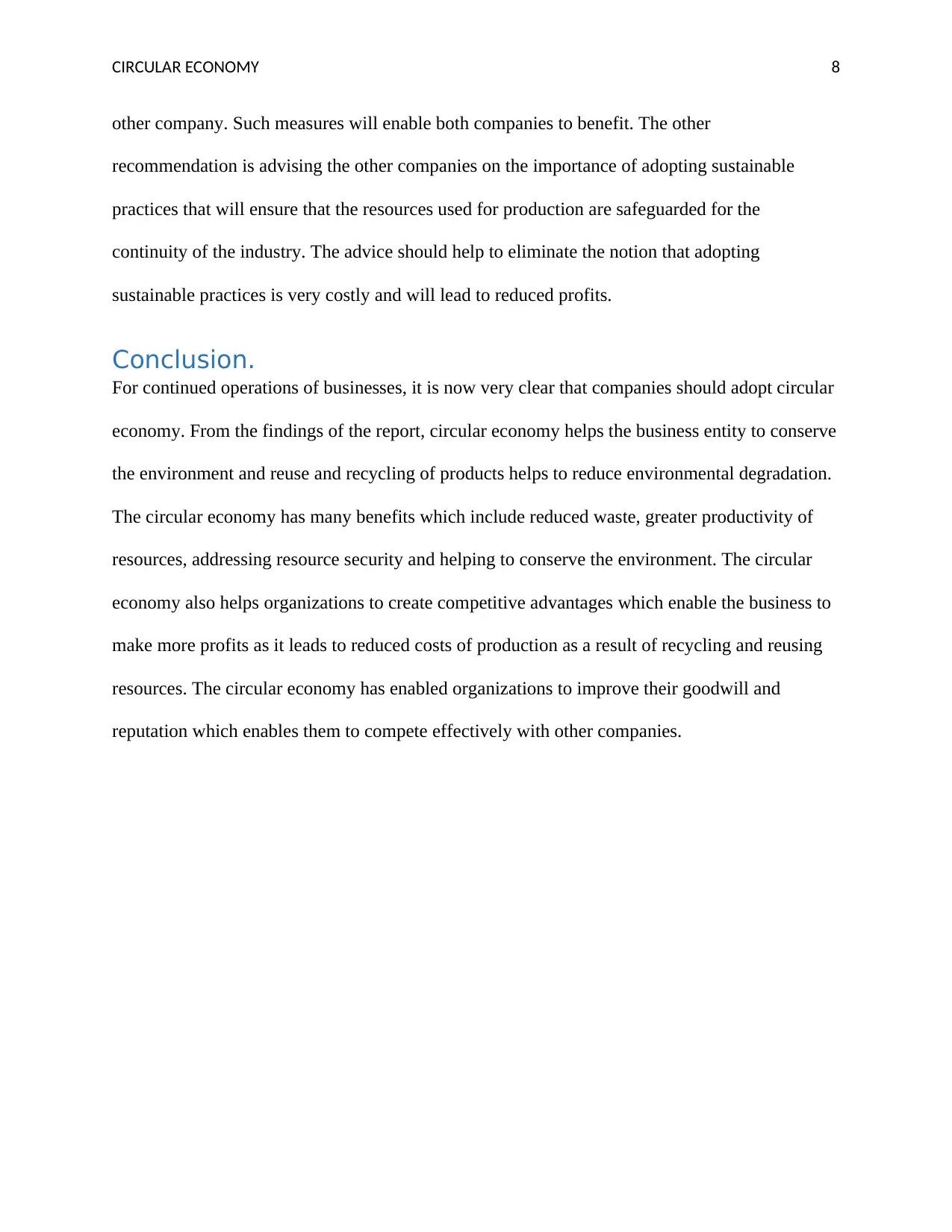
CIRCULAR ECONOMY 8
other company. Such measures will enable both companies to benefit. The other
recommendation is advising the other companies on the importance of adopting sustainable
practices that will ensure that the resources used for production are safeguarded for the
continuity of the industry. The advice should help to eliminate the notion that adopting
sustainable practices is very costly and will lead to reduced profits.
Conclusion.
For continued operations of businesses, it is now very clear that companies should adopt circular
economy. From the findings of the report, circular economy helps the business entity to conserve
the environment and reuse and recycling of products helps to reduce environmental degradation.
The circular economy has many benefits which include reduced waste, greater productivity of
resources, addressing resource security and helping to conserve the environment. The circular
economy also helps organizations to create competitive advantages which enable the business to
make more profits as it leads to reduced costs of production as a result of recycling and reusing
resources. The circular economy has enabled organizations to improve their goodwill and
reputation which enables them to compete effectively with other companies.
other company. Such measures will enable both companies to benefit. The other
recommendation is advising the other companies on the importance of adopting sustainable
practices that will ensure that the resources used for production are safeguarded for the
continuity of the industry. The advice should help to eliminate the notion that adopting
sustainable practices is very costly and will lead to reduced profits.
Conclusion.
For continued operations of businesses, it is now very clear that companies should adopt circular
economy. From the findings of the report, circular economy helps the business entity to conserve
the environment and reuse and recycling of products helps to reduce environmental degradation.
The circular economy has many benefits which include reduced waste, greater productivity of
resources, addressing resource security and helping to conserve the environment. The circular
economy also helps organizations to create competitive advantages which enable the business to
make more profits as it leads to reduced costs of production as a result of recycling and reusing
resources. The circular economy has enabled organizations to improve their goodwill and
reputation which enables them to compete effectively with other companies.
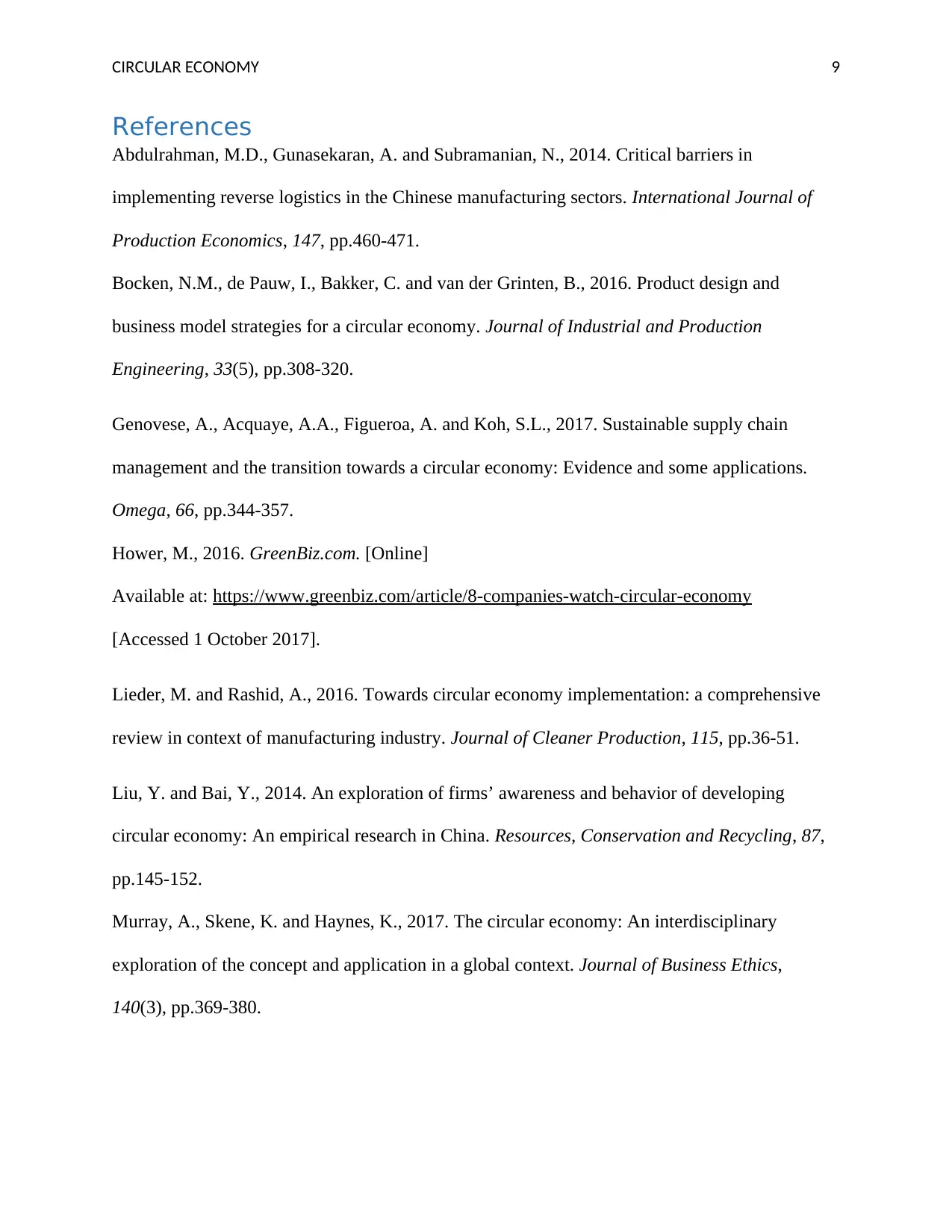
CIRCULAR ECONOMY 9
References
Abdulrahman, M.D., Gunasekaran, A. and Subramanian, N., 2014. Critical barriers in
implementing reverse logistics in the Chinese manufacturing sectors. International Journal of
Production Economics, 147, pp.460-471.
Bocken, N.M., de Pauw, I., Bakker, C. and van der Grinten, B., 2016. Product design and
business model strategies for a circular economy. Journal of Industrial and Production
Engineering, 33(5), pp.308-320.
Genovese, A., Acquaye, A.A., Figueroa, A. and Koh, S.L., 2017. Sustainable supply chain
management and the transition towards a circular economy: Evidence and some applications.
Omega, 66, pp.344-357.
Hower, M., 2016. GreenBiz.com. [Online]
Available at: https://www.greenbiz.com/article/8-companies-watch-circular-economy
[Accessed 1 October 2017].
Lieder, M. and Rashid, A., 2016. Towards circular economy implementation: a comprehensive
review in context of manufacturing industry. Journal of Cleaner Production, 115, pp.36-51.
Liu, Y. and Bai, Y., 2014. An exploration of firms’ awareness and behavior of developing
circular economy: An empirical research in China. Resources, Conservation and Recycling, 87,
pp.145-152.
Murray, A., Skene, K. and Haynes, K., 2017. The circular economy: An interdisciplinary
exploration of the concept and application in a global context. Journal of Business Ethics,
140(3), pp.369-380.
References
Abdulrahman, M.D., Gunasekaran, A. and Subramanian, N., 2014. Critical barriers in
implementing reverse logistics in the Chinese manufacturing sectors. International Journal of
Production Economics, 147, pp.460-471.
Bocken, N.M., de Pauw, I., Bakker, C. and van der Grinten, B., 2016. Product design and
business model strategies for a circular economy. Journal of Industrial and Production
Engineering, 33(5), pp.308-320.
Genovese, A., Acquaye, A.A., Figueroa, A. and Koh, S.L., 2017. Sustainable supply chain
management and the transition towards a circular economy: Evidence and some applications.
Omega, 66, pp.344-357.
Hower, M., 2016. GreenBiz.com. [Online]
Available at: https://www.greenbiz.com/article/8-companies-watch-circular-economy
[Accessed 1 October 2017].
Lieder, M. and Rashid, A., 2016. Towards circular economy implementation: a comprehensive
review in context of manufacturing industry. Journal of Cleaner Production, 115, pp.36-51.
Liu, Y. and Bai, Y., 2014. An exploration of firms’ awareness and behavior of developing
circular economy: An empirical research in China. Resources, Conservation and Recycling, 87,
pp.145-152.
Murray, A., Skene, K. and Haynes, K., 2017. The circular economy: An interdisciplinary
exploration of the concept and application in a global context. Journal of Business Ethics,
140(3), pp.369-380.
⊘ This is a preview!⊘
Do you want full access?
Subscribe today to unlock all pages.

Trusted by 1+ million students worldwide
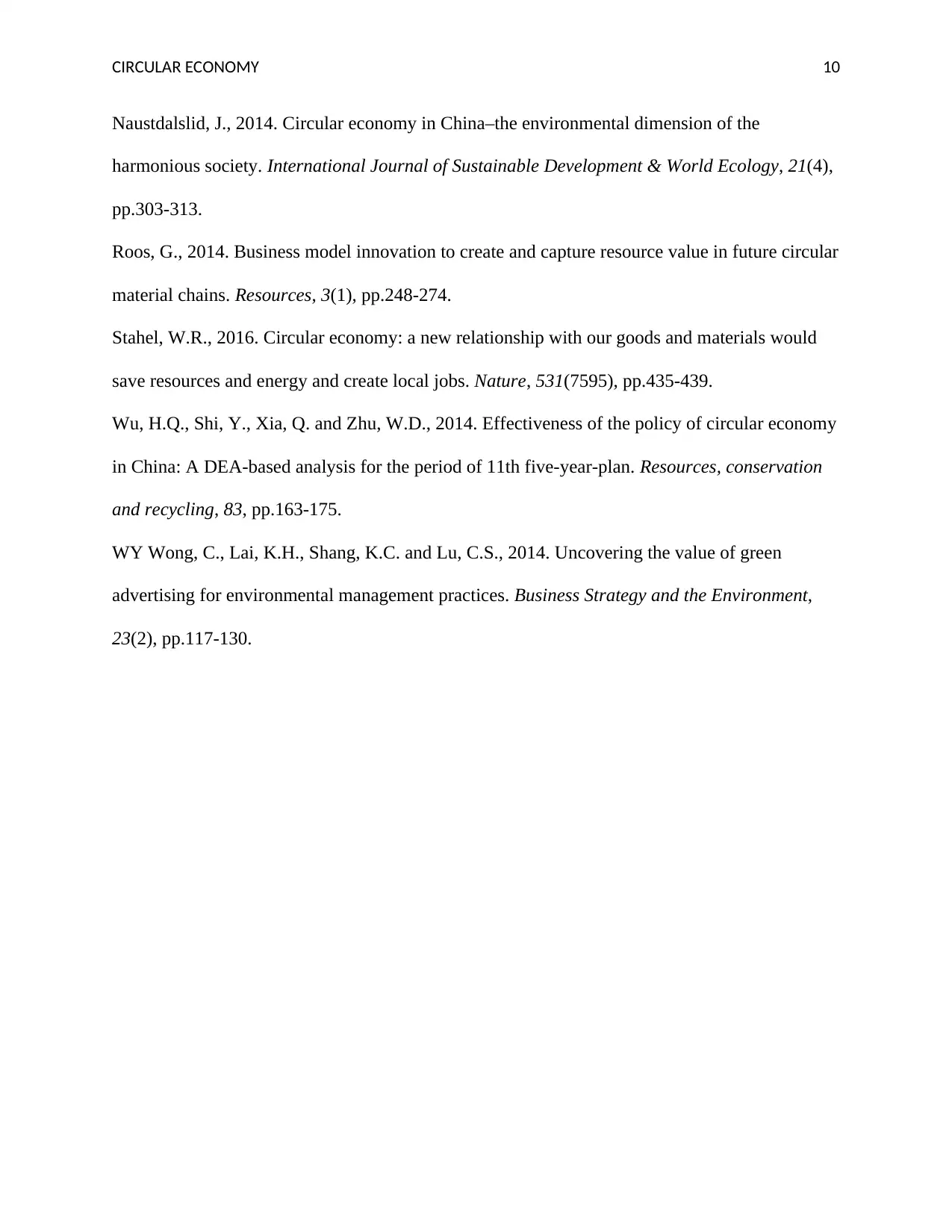
CIRCULAR ECONOMY 10
Naustdalslid, J., 2014. Circular economy in China–the environmental dimension of the
harmonious society. International Journal of Sustainable Development & World Ecology, 21(4),
pp.303-313.
Roos, G., 2014. Business model innovation to create and capture resource value in future circular
material chains. Resources, 3(1), pp.248-274.
Stahel, W.R., 2016. Circular economy: a new relationship with our goods and materials would
save resources and energy and create local jobs. Nature, 531(7595), pp.435-439.
Wu, H.Q., Shi, Y., Xia, Q. and Zhu, W.D., 2014. Effectiveness of the policy of circular economy
in China: A DEA-based analysis for the period of 11th five-year-plan. Resources, conservation
and recycling, 83, pp.163-175.
WY Wong, C., Lai, K.H., Shang, K.C. and Lu, C.S., 2014. Uncovering the value of green
advertising for environmental management practices. Business Strategy and the Environment,
23(2), pp.117-130.
Naustdalslid, J., 2014. Circular economy in China–the environmental dimension of the
harmonious society. International Journal of Sustainable Development & World Ecology, 21(4),
pp.303-313.
Roos, G., 2014. Business model innovation to create and capture resource value in future circular
material chains. Resources, 3(1), pp.248-274.
Stahel, W.R., 2016. Circular economy: a new relationship with our goods and materials would
save resources and energy and create local jobs. Nature, 531(7595), pp.435-439.
Wu, H.Q., Shi, Y., Xia, Q. and Zhu, W.D., 2014. Effectiveness of the policy of circular economy
in China: A DEA-based analysis for the period of 11th five-year-plan. Resources, conservation
and recycling, 83, pp.163-175.
WY Wong, C., Lai, K.H., Shang, K.C. and Lu, C.S., 2014. Uncovering the value of green
advertising for environmental management practices. Business Strategy and the Environment,
23(2), pp.117-130.
1 out of 10
Related Documents
Your All-in-One AI-Powered Toolkit for Academic Success.
+13062052269
info@desklib.com
Available 24*7 on WhatsApp / Email
![[object Object]](/_next/static/media/star-bottom.7253800d.svg)
Unlock your academic potential
Copyright © 2020–2025 A2Z Services. All Rights Reserved. Developed and managed by ZUCOL.





